Evaluation of Water Content in an Active Layer Using Penetration-Type Time Domain Reflectometry
Abstract
:Featured Application
Abstract
1. Introduction
2. Penetration-Type TDR (PTDR)
2.1. Principle of TDR
2.2. Design
3. Laboratory Tests
3.1. Soils Sampled in Ny-Alesund
3.2. Relationship between ka and θ
3.3. Temperature Effect
4. Field Tests
4.1. PTDR Application
4.2. Electrical Resistivity Survey
4.3. Correlation between θ and ρ
5. Summary and Conclusions
Author Contributions
Funding
Conflicts of Interest
References
- Lachenbruch, A.H. Permafrost, the Active Layer, and Changing Climate; U.S. Geological Survey: Menlo Park, CA, USA, 1994. [Google Scholar]
- Nelson, F.E.; Lachenbruch, A.H.; Woo, M.-K.; Koster, E.A.; Osterkamp, T.E.; Gavrilova, M.K.; Guodong, C. Permafrost and Changing Climate. In Proceedings of the Sixth International Conference on Permafrost, Beijing, China, 5–9 July 1993; South China University of Technology: Wushan, Guangzhou, China, 1993. [Google Scholar]
- Boike, J.; Roth, K.; Overduin, P.P. Thermal and hydrologic dynamics of the active layer at a continuous permafrost site (Taymyr Peninsula, Siberia). Water Resour. Res. 1998, 34, 355–363. [Google Scholar] [CrossRef] [Green Version]
- Evett, S.R. Some aspects of time domain reflectometry, neutron scattering, and capacitance methods for soil water content measurement. In Proceedings of the International Atomic Energy Agency Symposium; International Atomic Energy Agency: Vienna, Austria, 2000; Volume 59, pp. 5–49. Available online: http://www.iaea.org/inis/collection/nclcollectionstore/_public/31/014/31014384.pdf#page=9 (accessed on 1 May 2018).
- Evett, S.R. Soil water measurement by neutron thermalization. Encyclopedia Water Sci. 2003, 889–893. [Google Scholar] [CrossRef]
- Tice, A.R.; Oliphant, J.L.; Nakano, Y.; Jenkins, T.F. Relationship between the Ice and Unfrozen Water Phases in Frozen Soil as Determined by Pulsed Nuclear Magnetic Resonance and Physical Desorption Data; No. CRREL-82-15; Cold Regions Research and Engineering Lab.: Hanover, NH, USA, 1982. [Google Scholar]
- Oliphant, J.L. A model for dielectric constants of frozen soils. In Freezing and Thawing of Soil-Water Systems; ASCE: New York, NY, USA, 1985; pp. 46–57. [Google Scholar]
- Black, P.B.; Tice, A.R. Comparison of soil freezing curve and soil water curve data for Windsor sandy loam. Water Resour. Res. 1989, 25, 2205–2210. [Google Scholar] [CrossRef]
- Reginato, R.J.; van Bavel, C.H.M. Soil Water Measurement with Gamma Attenuation 1. Soil Sci. Soc. Am. J. 1964, 28, 721–724. [Google Scholar] [CrossRef]
- Fellner-Feldegg, H. Measurement of dielectrics in the time domain. J. Phys. Chem. 1969, 73, 616–623. [Google Scholar] [CrossRef]
- Topp, G.C.; Davis, J.L.; Annan, A.P. Electromagnetic determination of soil water content: Measurements in coaxial transmission lines. Water Resour. Res. 1980, 16, 574–582. [Google Scholar] [CrossRef]
- Patterson, D.E.; Smith, M.W. The measurement of frozen water content by time domain reflectometry: Results from laboratory tests. Can. Geotech. J. 1981, 18, 131–144. [Google Scholar] [CrossRef]
- Topp, G.C.; Davis, J.L.; Annan, A.P. Electromagnetic determination of soil water content using TDR: II. Evaluation of installation and configuration of parallel transmission lines. Soil Sci. Soc. Am. J. 1982, 46, 678–684. [Google Scholar] [CrossRef]
- Smith, M.W.; Patterson, D.E. Determining the unfrozen water content in soils by time-domain reflectometry. Atmos.-Ocean 1984, 22, 261–263. [Google Scholar] [CrossRef]
- Topp, G.C.; Davis, J.L.; Bailey, W.G.; Zebchuk, W.D. The measurement of soil water content using a portable TDR hand probe. Can. J. Soil Sci. 1984, 64, 313–321. [Google Scholar] [CrossRef]
- Dasberg, S.; Dalton, F.N. Time domain reflectometry field measurements of soil water content and electrical conductivity. Soil Sci. Soc. Am. J. 1985, 49, 293–297. [Google Scholar] [CrossRef]
- Topp, G.C.; Davis, J.L. Measurement of soil water content using time-domain reflectometry (TDR): A field evaluation. Soil Sci. Soc. Am. J. 1985, 49, 19–24. [Google Scholar] [CrossRef]
- Drungil, C.E.C.; Abt, K.; Gish, T.J. Soil moisture determination in gravely soils with time domain reflectometry. Trans. ASAE 1989, 32, 177–180. [Google Scholar] [CrossRef]
- Hong, W.T.; Jung, Y.S.; Kang, S.; Lee, J.S. Estimation of soil-water characteristic curves in multiple-cycles using membrane and TDR system. Materials 2016, 9, 1019. [Google Scholar] [CrossRef] [PubMed]
- Skierucha, W.; Wilczek, A. A FDR sensor for measuring complex soil dielectric permittivity in the 10–500 MHz frequency range. Sensors 2010, 10, 3314–3329. [Google Scholar] [CrossRef] [PubMed]
- Wilczek, A.; Szypłowska, A.; Skierucha, W.; Cieśla, J.; Pichler, V.; Janik, G. Determination of Soil Pore Water Salinity Using an FDR Sensor Working at Various Frequencies up to 500 MHz. Sensors 2012, 12, 10890–10905. [Google Scholar] [CrossRef] [PubMed] [Green Version]
- Topp, G.C.; St-Amour, G.; Compton, B.A. Measuring cone resistance and water content with a TDR-penetrometer combination. In Proceedings of the 3rd Eastern Canada Soil Structure Workshop, Merrickville, ON, Canada, 21–22 August 1996; Volume 3, pp. 21–22. [Google Scholar]
- Young, G.D.; Adams, B.A.; Topp, G.C. A portable data collection system for simultaneous cone penetrometer force and volumetric soil water content measurements. Can. J. Soil Sci. 2000, 80, 23–31. [Google Scholar] [CrossRef] [Green Version]
- Nissen, H.H.; Moldrup, P.; Henriksen, K. High-resolution time domain reflectometry coil probe for measuring soil water content. Soil Sci. Soc. Am. J. 1998, 62, 1203–1211. [Google Scholar] [CrossRef]
- Vaz, C.M.P.; Hopmans, J.W. Simultaneous measurement of soil penetration resistance and water content with a combined penetrometer–TDR moisture probe. Soil Sci. Soc. Am. J. 2001, 65, 4–12. [Google Scholar] [CrossRef]
- Topp, G.C.; Lapen, D.R.; Edwards, M.J.; Young, G.D. Laboratory calibration, in-field validation and use of a soil penetrometer measuring cone resistance and water content. Vadose Zone J. 2003, 2, 633–641. [Google Scholar] [CrossRef]
- Kosugi, K.; Yamakawa, Y.; Masaoka, N.; Mizuyama, T. A combined penetrometer-moisture probe for surveying soil properties of natural hillslopes. Vadose Zone J. 2009, 8, 52–63. [Google Scholar] [CrossRef]
- Vaz, C.M.P.; Bassoi, L.H.; Hopmans, J.W. Contribution of water content and bulk density to field soil penetration resistance as measured by a combined cone penetrometer-TDR probe. Soil Tillage Res. 2001, 60, 35–42. [Google Scholar] [CrossRef]
- Lin, C.P.; Tang, S.H.; Chung, C.C. Development of TDR penetrometer through theoretical and laboratory investigations: 1. Measurement of soil dielectric permittivity. Geotech. Test. J. 2006, 29, 306–321. [Google Scholar]
- Miyamoto, T.; Fukami, K.; Chikushi, J. Simultaneous measurement of soil water and soil hardness using a modified time domain reflectometry probe and a conventional cone penetrometer. Soil Use Manag. 2012, 28, 240–248. [Google Scholar] [CrossRef]
- Maheshwarla, S.V.; Venkatasubramanian, R.; Boehm, R.F. Comparison of time domain reflectometry performance factors for several dielectric geometries: Theory and experiments. Water Resour. Res. 1995, 31, 1927–1933. [Google Scholar] [CrossRef]
- Baker, J.M.; Allmaras, R.R. System for automating and multiplexing soil moisture measurement by time-domain reflectometry. Soil Sci. Soc. Am. J. 1990, 54, 1–6. [Google Scholar] [CrossRef]
- Alharthi, A.; Lange, J. Soil water saturation: Dielectric determination. Water Resour. Res. 1987, 23, 591–595. [Google Scholar] [CrossRef]
- Ledieu, J.; De Ridder, P.; De Clerck, P.; Dautrebande, S. A method measuring soil water moisture by time-domain reflectometry. J. Hydrol. 1986, 88, 319–328. [Google Scholar] [CrossRef]
- Zegelin, S.J.; White, I.; Jenkins, D.R. Improved field probes for soil water content and electrical conductivity measurement using time domain reflectometry. Water Resour. Res. 1989, 25, 2367–2376. [Google Scholar] [CrossRef]
- Byun, Y.H.; Yoon, H.K.; Kim, Y.S.; Hong, S.S.; Lee, J.S. Active layer characterization by instrumented dynamic cone penetrometer in Ny-Alesund, Svalbard. Cold Reg. Sci. Technol. 2014, 104, 45–53. [Google Scholar] [CrossRef]
- Holtz, R.D.; Kovacs, W.D.; Sheahan, T.C. An Introduction to Geotechnical Engineering, 2nd ed.Prentice Hall: Englewood Cliffs, NJ, USA, 2011; 747p. [Google Scholar]
- BS 1377. Methods of Test for Soils for Civil Engineering Purposes: Part 2; British Standard Institution: London, UK, 1990. [Google Scholar]
- ASTM D4318. Standard test methods for liquid limit, plastic limit, and plasticity index of soils. In Annual Book of ASTM Standard 04.08; ASTM International: West Conshohocken, PA, USA, 2010. [Google Scholar]
- Roth, K.; Schulin, R.; Flühler, H.; Attinger, W. Calibration of time domain reflectometry for water content measurement using a composite dielectric approach. Water Resour. Res. 1990, 26, 2267–2273. [Google Scholar] [CrossRef]
- Lide, D.R. CRC Handbook of Chemistry and Physics, 77th ed.; CRC Press: Boca Raton, FL, USA, 1996. [Google Scholar]
- Yu, C.; Warrick, W.; Conklin, M.H. Derived functions of time domain reflectometry for soil mois ture measurements. Water Resour. Res. 1999, 35, 1789–1796. [Google Scholar] [CrossRef]
- Ferré, P.A.; Knight, J.H.; Rudolph, D.L.; Kachanoski, R.G. The sample area of conventional and alternative time domain reflectometry probes, Water Resour. Res. 1998, 34, 2971–2979. [Google Scholar]
- Or, D.; Wraith, J.M. Temperature effects on soil bulk dielectric permittivity measured by time domain reflectometry: A physical model. Water Resour. Res. 1999, 35, 371–383. [Google Scholar] [CrossRef] [Green Version]
- Roth, K.; Boike, J. Quantifying the thermal dynamics of a permafrost site near Ny-Ålesund, Svalbard. Water Resour. Res. 2001, 37, 2901–2914. [Google Scholar] [CrossRef] [Green Version]
- Salako, A.O.; Adepelumi, A.A. Evaluation of hydraulic conductivity of subsoil using electrical resistivity and ground penetrating radar data: Example from Southwestern Nigeria. Int. J. Geo-Eng. 2016, 7. [Google Scholar] [CrossRef]
- Kim, J.H. Dipro for Windows v. 4.0 Manual; HeeSong-Geotech: Daejeon, Korea, 1996. [Google Scholar]
- Calamita, G.; Brocca, L.; Perrone, A.; Piscitelli, S.; Lapenna, V.; Melone, F.; Moramarco, T. Electrical resistivity and TDR methods for soil moisture estimation in central Italy test-sites. J. Hydrol. 2012, 454, 101–112. [Google Scholar] [CrossRef]
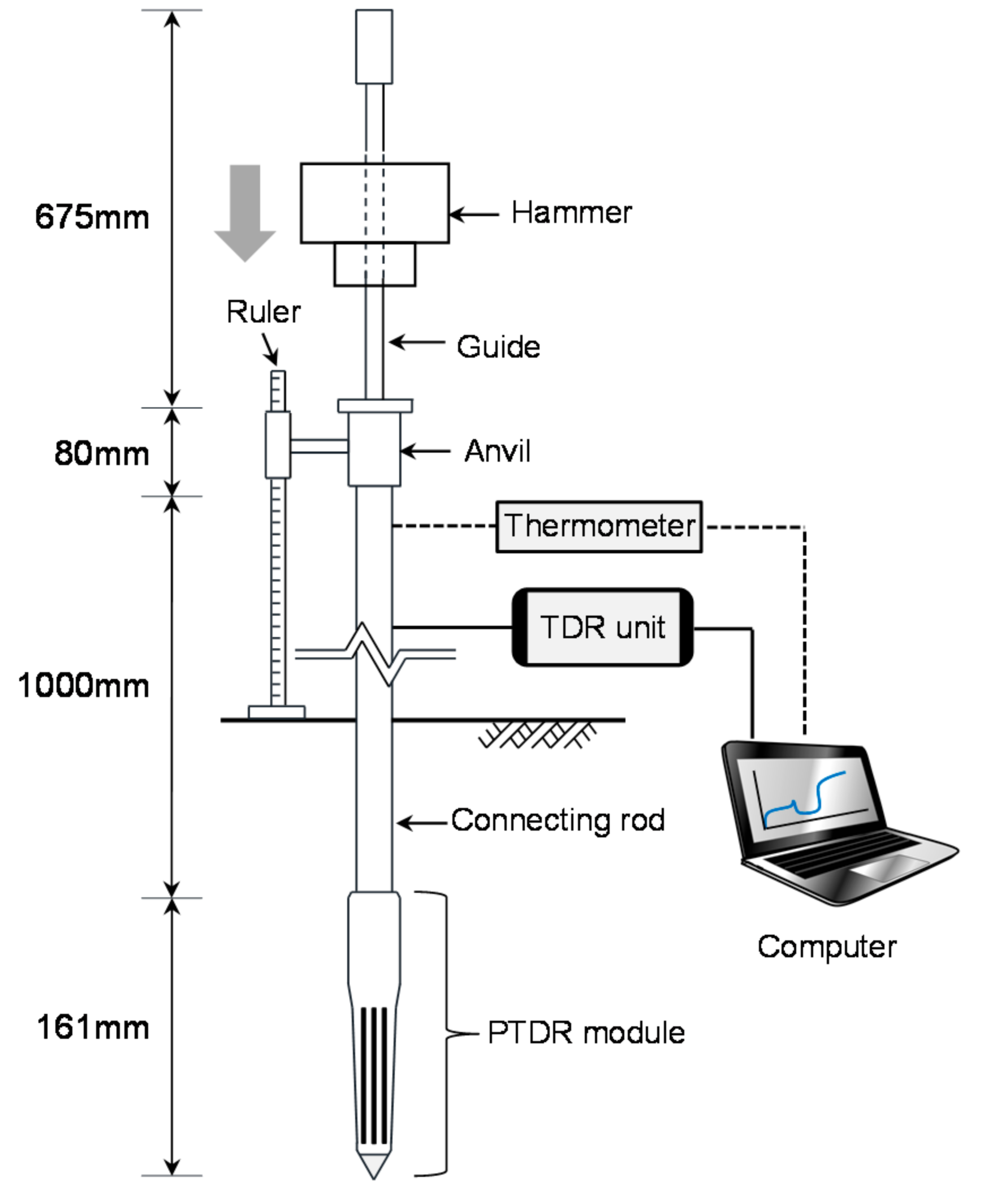

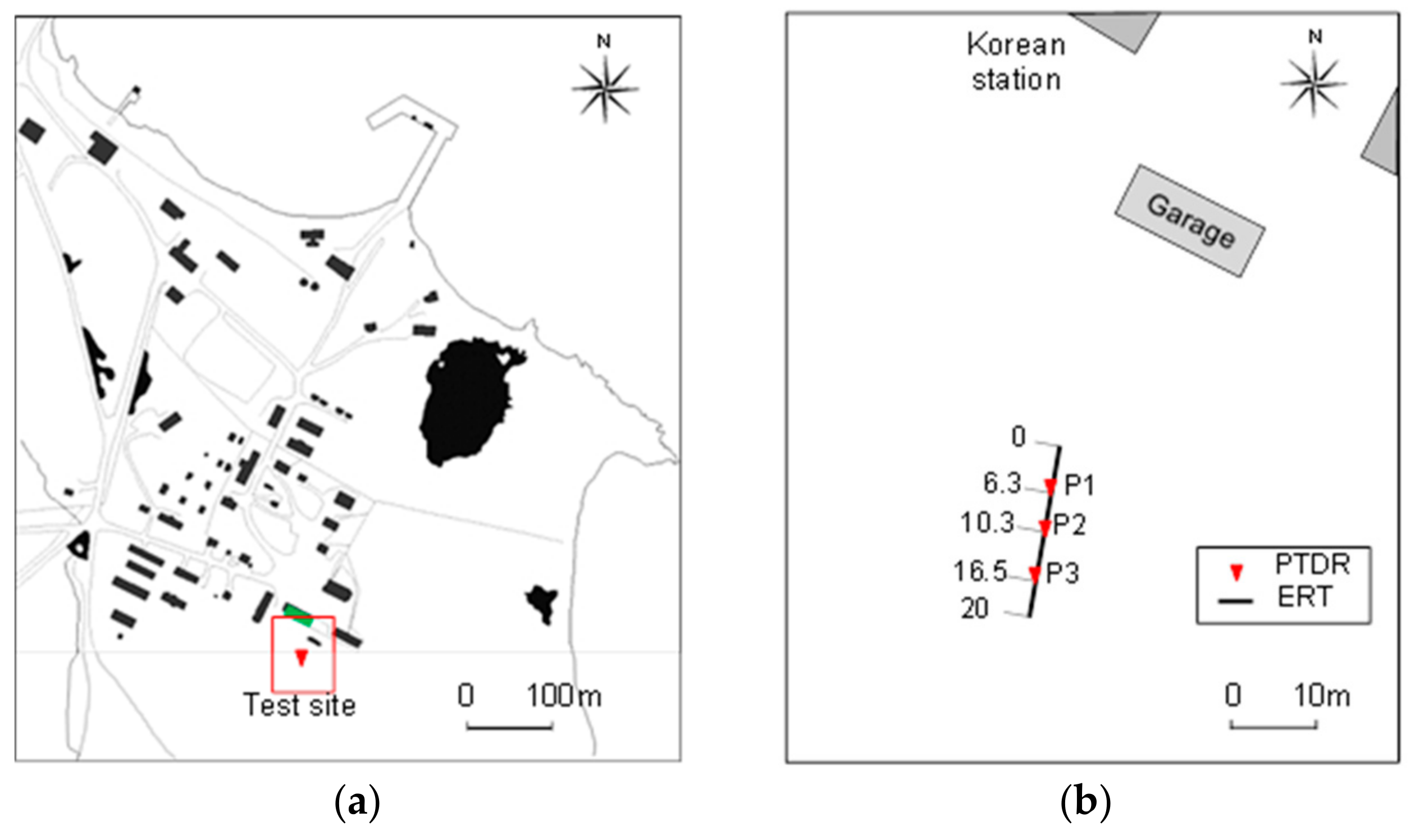
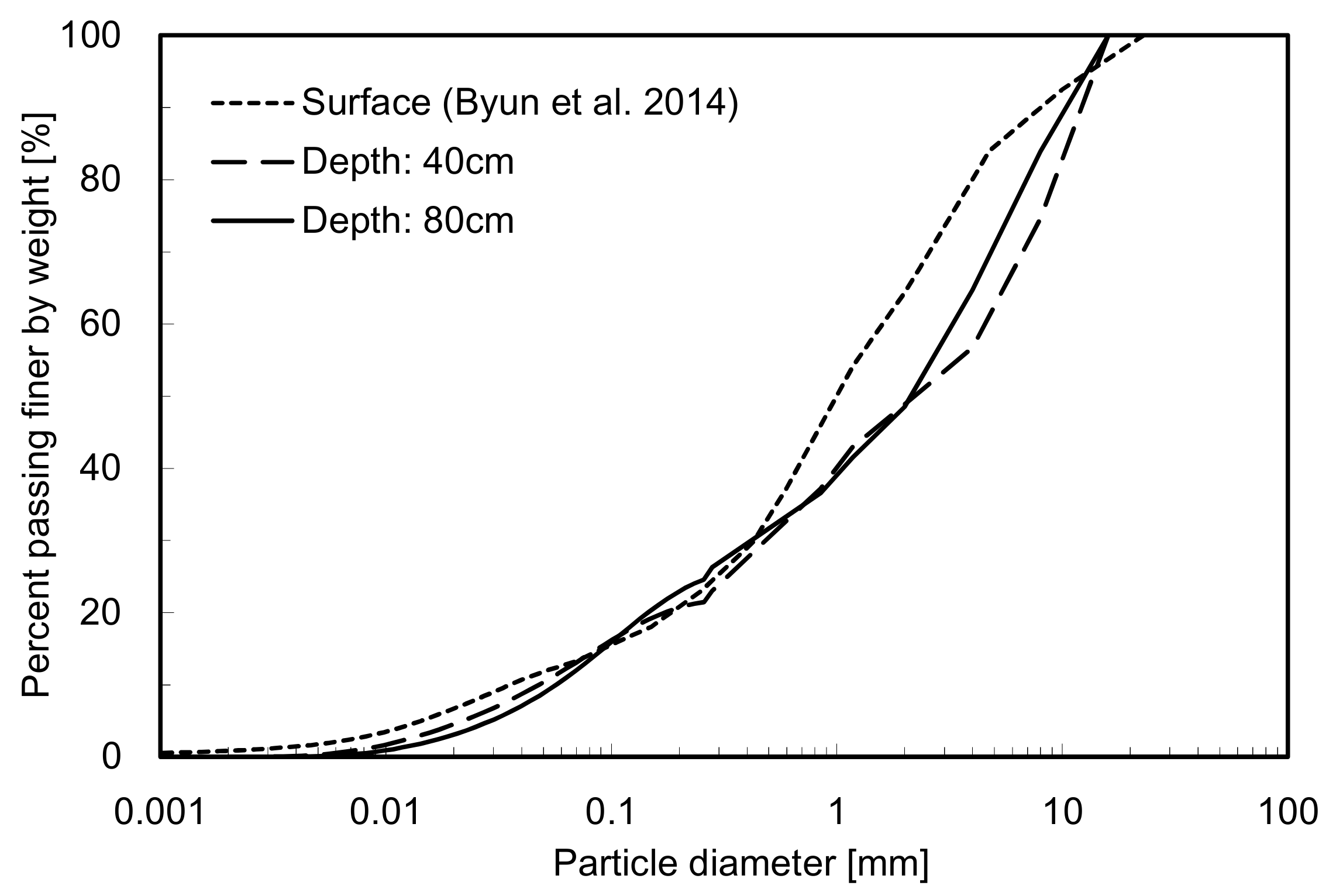
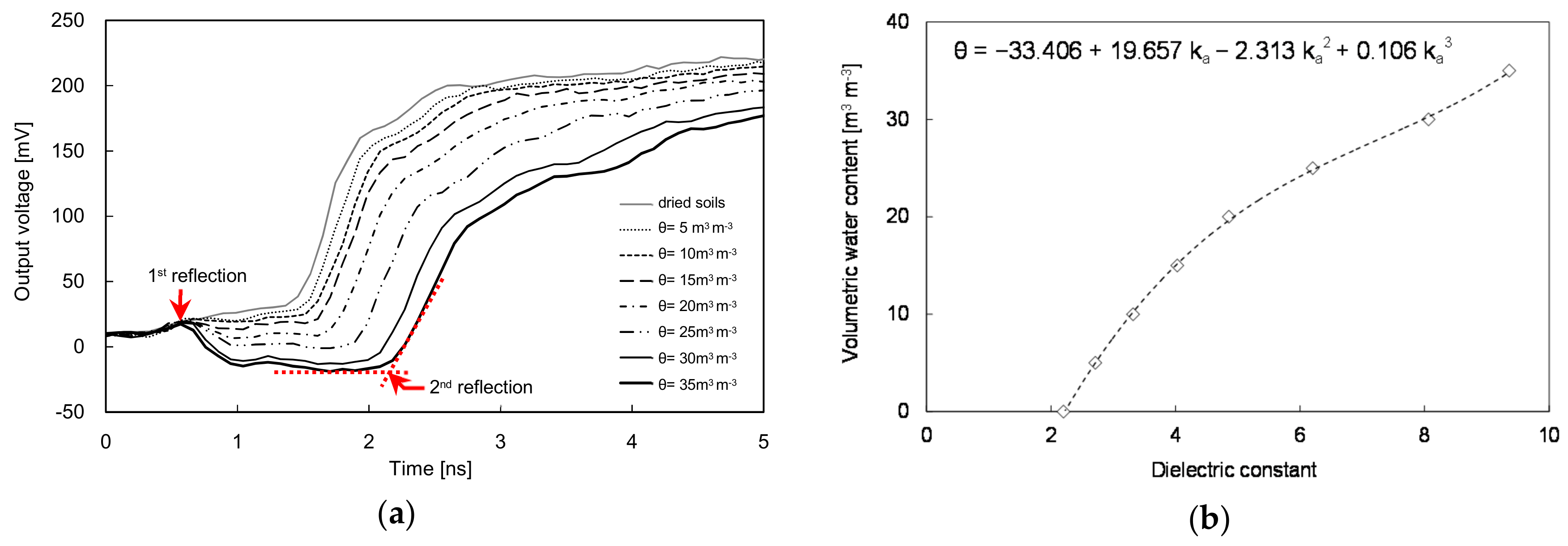
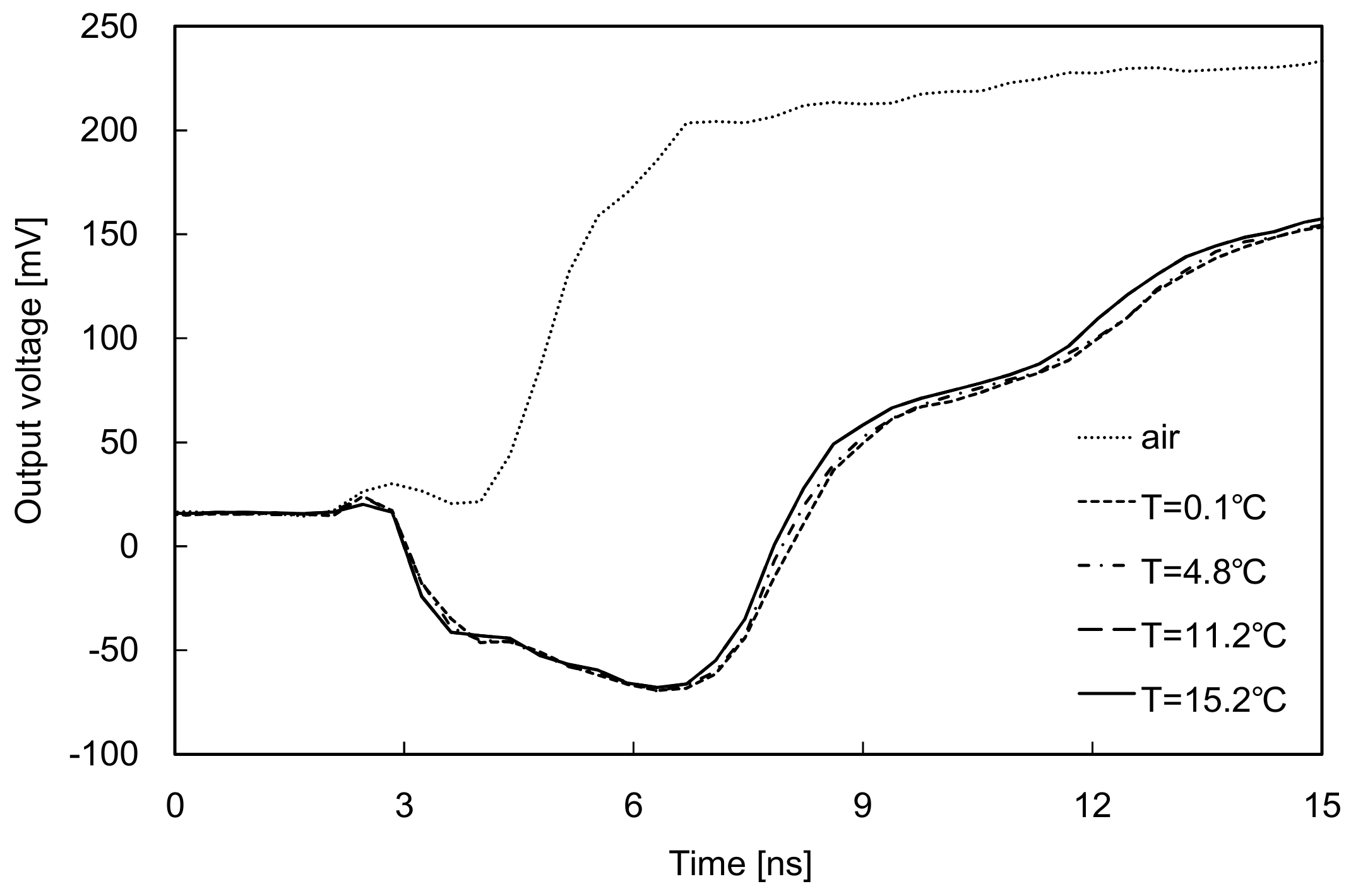
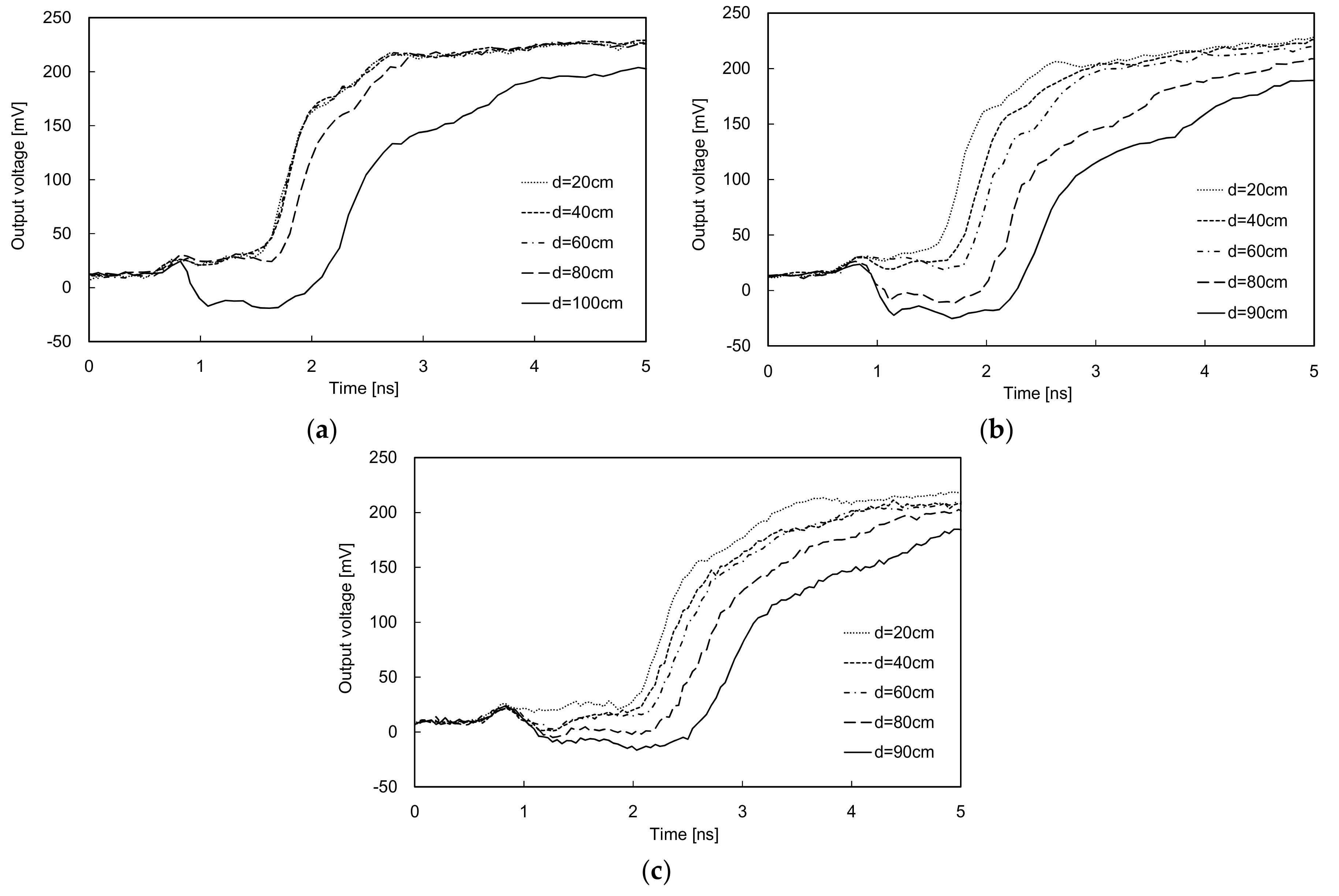
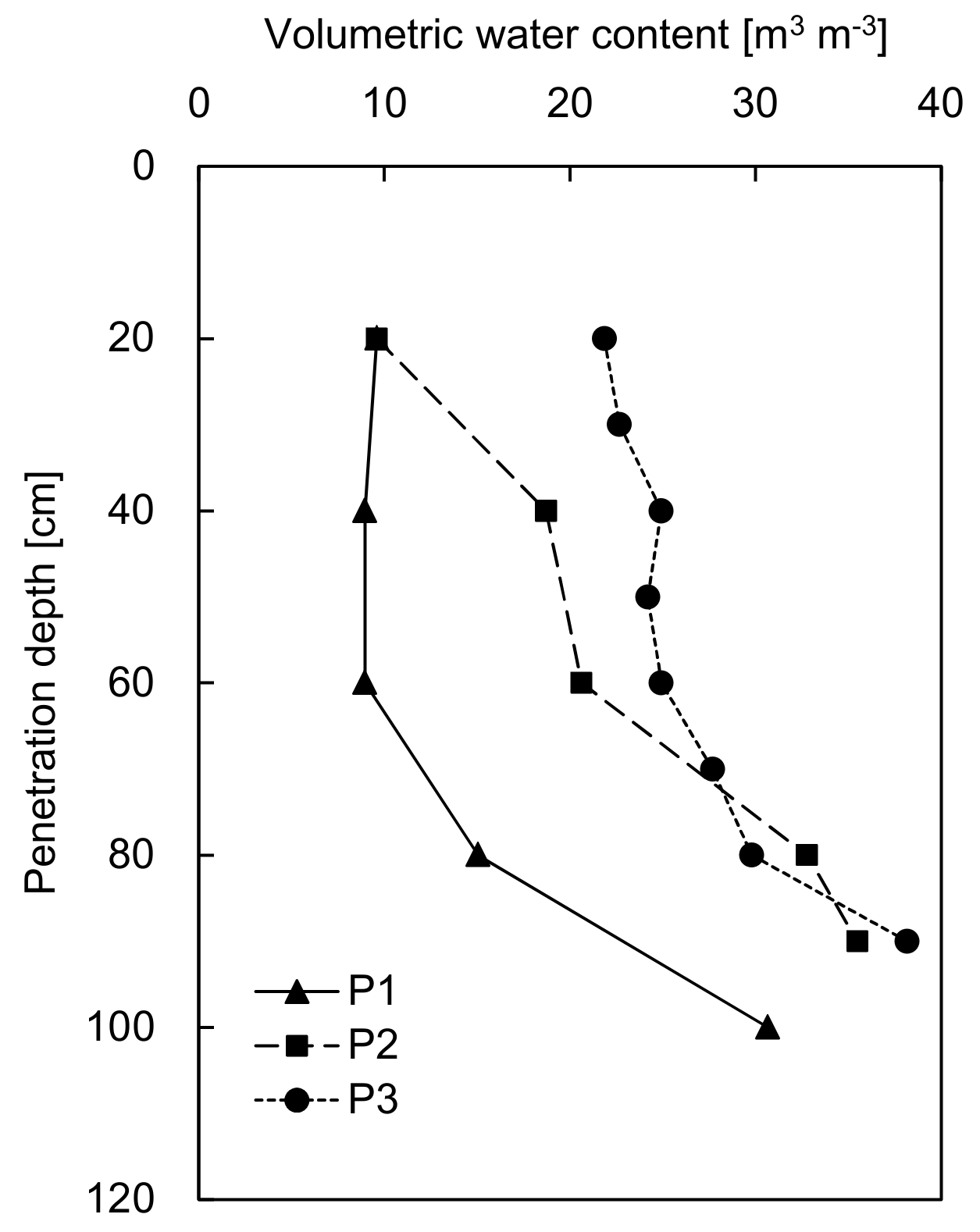
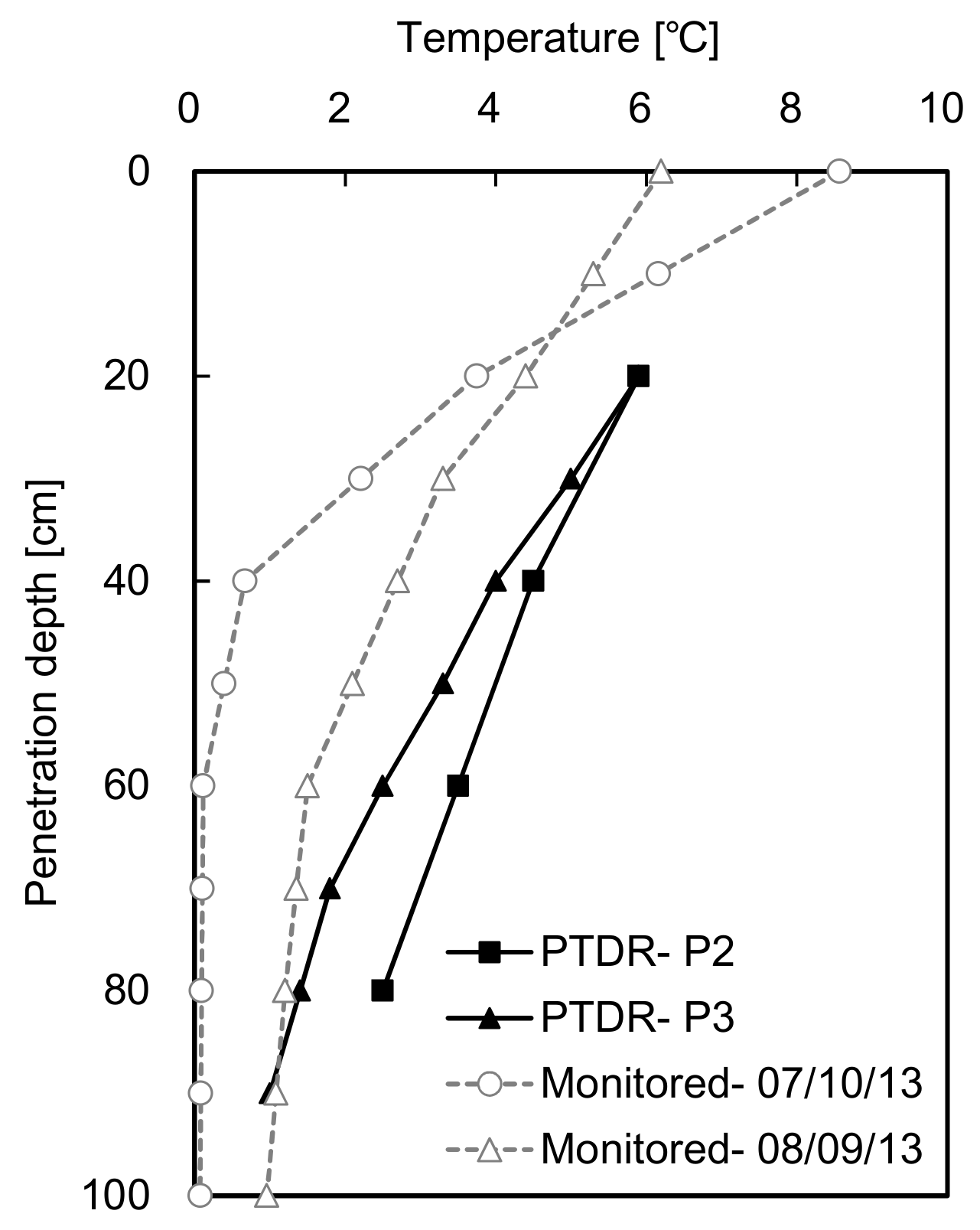
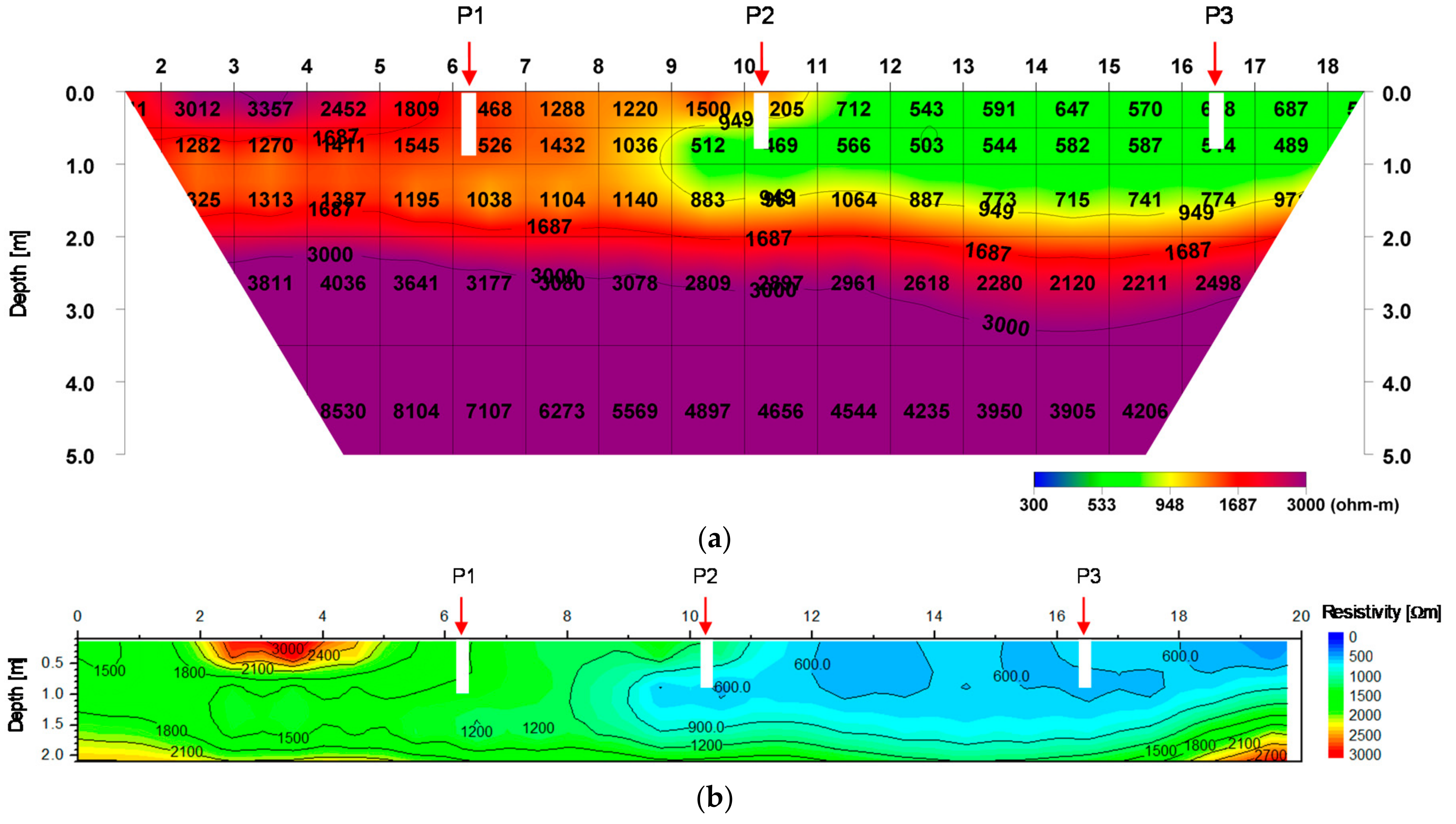

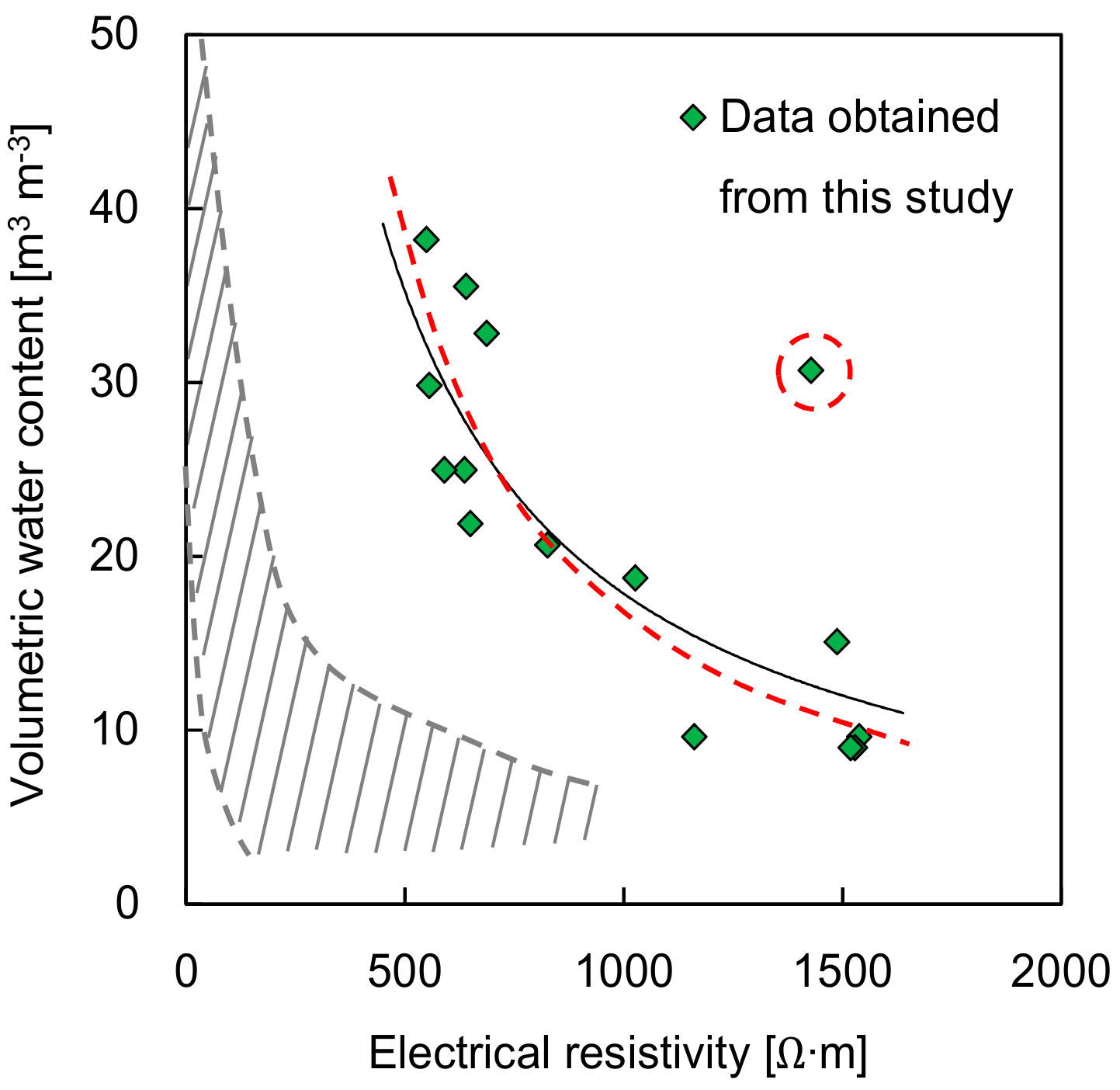
| Depth (mm) | Specific Gravity | Median Diameter (mm) | Gradation Coefficient | Uniformity Coefficient | Gravimetric Water Content (%) | Liquid Limit (%) | Plastic Limit (%) | Plastic Index (%] | USCS |
|---|---|---|---|---|---|---|---|---|---|
| 0 | 2.56 | 1.04 | 3.2 | 46.4 | 16.9 | 30.0 | 25.4 | 4.6 | SM |
| 40 | 2.68 | 2.29 | 1.4 | 98.7 | 5.5 | 31.6 | 24.5 | 7.1 | SM |
| 80 | 2.66 | 2.18 | 1.0 | 59.1 | 5.8 | 33.4 | 23.8 | 9.6 | SM |
| Data | Coefficient, a | Exponent, b | Coefficient of Determination, R2 | Standard Deviation of Regression, σ | p-Value | |
|---|---|---|---|---|---|---|
| a | b | |||||
| Entire | 15,592 | −0.98 | 0.61 | 0.34 | 1.96 × 10−5 | 0.00058 |
| Selected | 53,471 | −1.172 | 0.84 | 0.22 | 1.35 × 10−7 | 3.78 × 10−6 |
© 2018 by the authors. Licensee MDPI, Basel, Switzerland. This article is an open access article distributed under the terms and conditions of the Creative Commons Attribution (CC BY) license (http://creativecommons.org/licenses/by/4.0/).
Share and Cite
Lee, J.-S.; Hong, W.-T.; Park, K.; Hong, S.S.; Lee, S.-H.; Byun, Y.-H. Evaluation of Water Content in an Active Layer Using Penetration-Type Time Domain Reflectometry. Appl. Sci. 2018, 8, 935. https://doi.org/10.3390/app8060935
Lee J-S, Hong W-T, Park K, Hong SS, Lee S-H, Byun Y-H. Evaluation of Water Content in an Active Layer Using Penetration-Type Time Domain Reflectometry. Applied Sciences. 2018; 8(6):935. https://doi.org/10.3390/app8060935
Chicago/Turabian StyleLee, Jong-Sub, Won-Taek Hong, Keunbo Park, Seung Seo Hong, Sang-Ho Lee, and Yong-Hoon Byun. 2018. "Evaluation of Water Content in an Active Layer Using Penetration-Type Time Domain Reflectometry" Applied Sciences 8, no. 6: 935. https://doi.org/10.3390/app8060935





